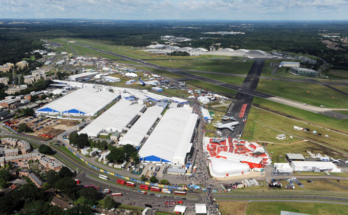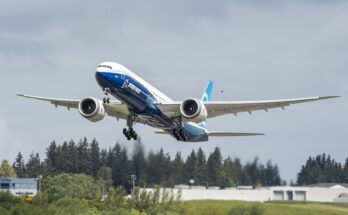By J. Kasper Oestergaard, European Correspondent.
Boeing and Airbus delivered 49 and 22 commercial jets in January 2016, down from 50 and 36 in January 2015, respectively. While Airbus traditionally delivers relatively few aircraft during the month of January, deliveries were unusually low this year.
In 2015, Boeing delivered 762 aircraft, ahead of Airbus’ 635, and both companies beat their 2015 delivery targets of 750-755 and ~630 aircraft, respectively. In 2014 and 2013, Boeing delivered a total of 723 and 648 jets, respectively, compared to Airbus’ 629 and 626.
Boeing has been able to increase deliveries significantly in recent years, mainly due to the ramp-up in production of the 787 Dreamliner (135 delivered in 2015). Airbus is slowly ramping up deliveries of its A350 XWB and this, combined with a higher A320 production rate of 46 per month from Q2 2016, means that the company will soon begin narrowing the gap in the deliveries race. In January, Airbus delivered four A330s, one A380 and 17 A320s, including the first A320neo, which was delivered to German legacy carrier Lufthansa on January 20. No A350s were delivered during the month of January, but Airbus has delivered 15 A350s to date (the first aircraft was delivered in December 2014). The company expects to deliver more than 100 A350s in 2018, when the production rate hits 10 per month. In January, Boeing delivered 35 737s, one 747-8, six 777s, and seven 787s.
In the orders race, Airbus had a very quiet month and booked just nine net new orders (16 gross orders minus seven cancellations). During the month of January, Airbus landed an order for 14 A330-900neo widebody jets from an unidentified customer, as well as an order from China Aircraft Leasing Group for two A320ceo narrowbody airliners. Boeing had a fairly strong month and booked 67 net new orders, including a United Airlines order for 40 737-700s as well as an order from the U.S. Navy for 20 737-based P-8A Poseidon maritime patrol aircraft (16 for the U.S. Navy and four for the Royal Australian Air Force). Also in January, Air China ordered six 777-300ERs, while Air Lease Corporation (ALC) placed an order for a single 787-9 Dreamliner. Boeing currently plans to raise its 737 production rate from 42 per month today to 47 and 52 in 2017 and 2018, respectively. In January 2016, Boeing’s CEO Dennis Muilenburg announced that demand supports a further increase to 57 737s per month in 2019.
In 2015, Airbus booked a total of 1,036 net orders, while Boeing finished the year with 768 net new orders, or 268 fewer than Airbus. In both 2014 and 2013, Airbus won the orders race with 1,456 and 1,503 net new orders, respectively, ahead of Boeing with 1,432 and 1,355. In 2015, net new orders for both Boeing and Airbus were significantly down from their 2014 levels, due, among other factors, to the sharp decline in the price of oil. Cheaper oil makes it financially more attractive for airlines to keep operating older, less fuel-efficient aircraft. On January 20, the U.S. WTI oil price closed at $26.68, the lowest level since May 2003.
Airbus’ order backlog as of January 31, 2016, stands at 6,818 jets (of which 5,568, or 82%, are A320 narrowbodies), ahead of Boeing’s 5,813 (of which 4,417, or 76%, are 737 narrowbodies). The big question is whether the massive backlogs have peaked or whether backlogs will continue to grow throughout 2016. According to both Airbus and Boeing, the demand for passenger aircraft is tied to the growth in worldwide revenue passenger miles (rpms), which again is highly correlated with global GDP growth.
Boeing 777 Rate Cut Announced
Boeing and Airbus are both facing challenges going forward. Boeing is struggling to bridge the gap in production between its current-generation 777 (777F and 777-300ER) and the future 777X to maintain the current production rate of 8.3 per month (100 per year). The 777 is a very profitable aircraft for Boeing and an important “cash cow.” In 2015, Boeing only booked 38 orders for the 777 (16 777Fs and 22 777-300ERs). In recent months, we have made the case that Boeing will likely cut the rate to first seven per month (84 per year) and later six per month (72 per year). On January 27, in connection with the presentation of the company’s 2015 financial results and forecast for 2016, Boeing’s CEO Dennis Muilenburg announced that the company will reduce the 777 production rate by 16 percent in 2017 to 84 aircraft per year. Boeing also indicated that in 2018, as it begins to build the first of four 777X test aircraft, production of the current-generation 777 will likely sink below seven per month. We would like to emphasize that without a large increase in orders, Boeing could very likely be forced to cut the rate to six per month as soon as 2017. Boeing has remained upbeat on the 777 order intake for quite some time, but orders are simply not coming in fast enough and in sufficient quantities.
Airbus Ramping Up A320 and A350 Output
Airbus faces challenges now that production and deliveries of the A350 XWB will be ramping up in the coming years. The company plans to produce 10 aircraft per month by 2018. Also, the company plans to increase the monthly production rate of the A320 to 46 this year and to 60 by mid-2019. The company delivered the first A320neo in January 2016. Airbus has officially opened its new A320 final assembly line in Mobile, Alabama, the company’s first production site in America. Deliveries from Mobile are scheduled to begin in 2016 and to reach an annual output of 40 to 50 A320 series jets by 2018.
A380 Uncertainty
Another major challenge for Airbus centers on the future of the A380 as the company considers launching NEO and stretch variants of the aircraft. The company has to make a tough choice: either 1) invest billions in developing the NEO and stretch to reduce the aircraft’s cost per seat mile; or 2) phase out the platform and terminate production when orders run out in four or five years. In December 2015, after a long order drought, Airbus was able to book an order for three A380 superjumbos from an unidentified customer. On January 29, 2016, the customer was confirmed as All Nippon Airways (ANA). The airline becomes the first Japanese operator of the A380, and will take delivery of the first jet in 2019. ANA plans to use the planes on flights from Tokyo to Honolulu.

References:
http://www.boeing.com/commercial/#/orders-deliveries
http://www.airbus.com/company/market/orders-deliveries/
http://www.airbus.com/company/americas/us/alabama/
http://www.eia.gov/dnav/pet/hist/LeafHandler.ashx?n=PET&s=RWTC&f=D
The Forecast International Civil Aircraft service covers all facets of the fixed-wing commercial and private aviation industry. It includes more than 70 detailed reports, complete with production forecasts on individual civil aircraft families. Four Market Segment Analyses provide in-depth examination of the markets for Large Commercial Jet Transports, Regional Aircraft, Business Jets, and General Aviation/Utility Aircraft. Included in the reports are production forecasts, a Forecast Rationale detailing the basis for the forecast, the aircraft’s price range and technical specifications, a program history, and recent developments.
A military history enthusiast, Richard began at Forecast International as editor of the World Weapons Weekly newsletter. As the Internet grew in importance as a research tool, he helped design the company's Forecast Intelligence Center and currently coordinates the EMarket Alert newsletters for clients. Richard also manages social media efforts, including two new blogs: Defense & Security Monitor, covering defense systems and international issues, and Flight Plan, which focuses on commercial aviation and space systems. For over 30 years, Richard has authored the Defense & Aerospace Companies, Volume I (North America) and Volume II (International) services. The two books provide detailed data on major aerospace and defense contractors. He also edits the International Contractors service, a database that tracks all the contractors involved in the programs covered in the FI library. More recently he was appointed Manager, Information Services Group (ISG), a new unit that encompasses developing outbound content for both Forecast International and Military Periscope.




